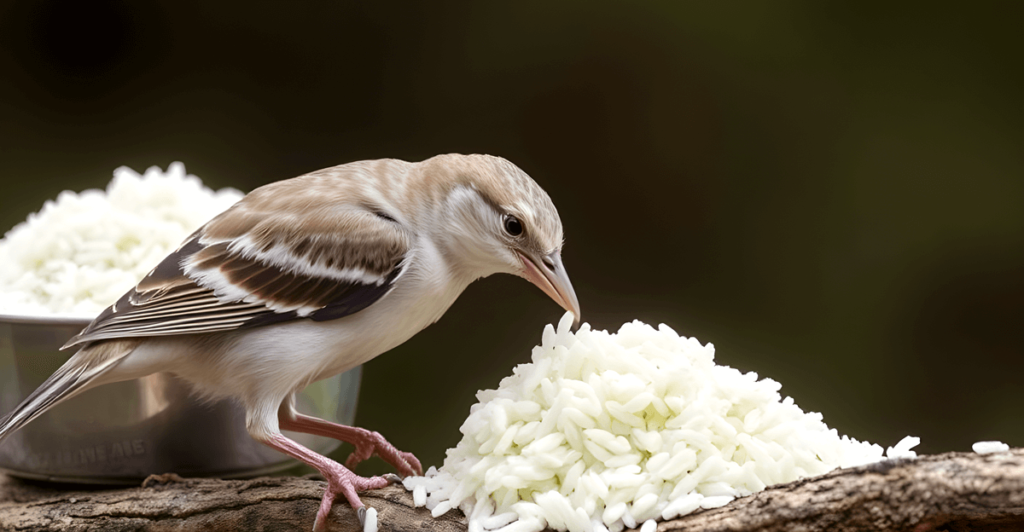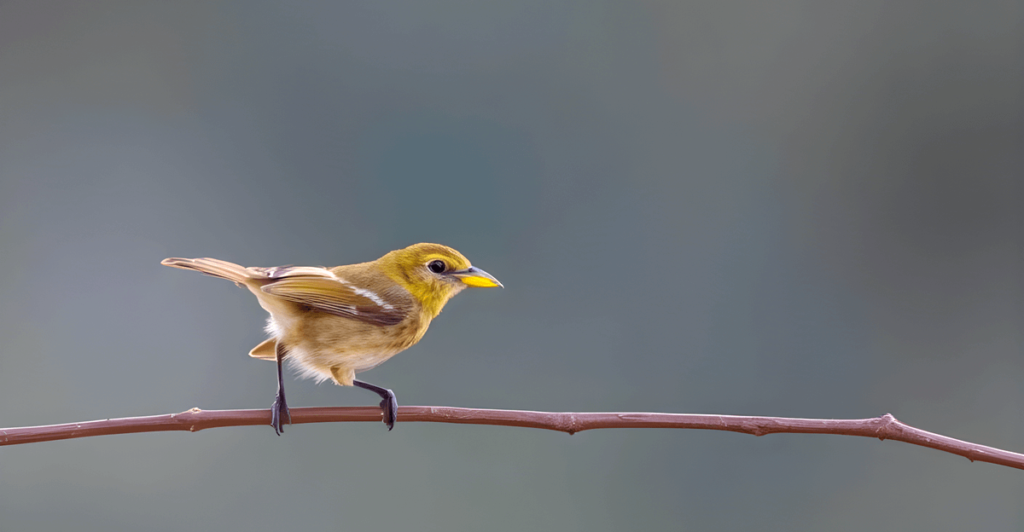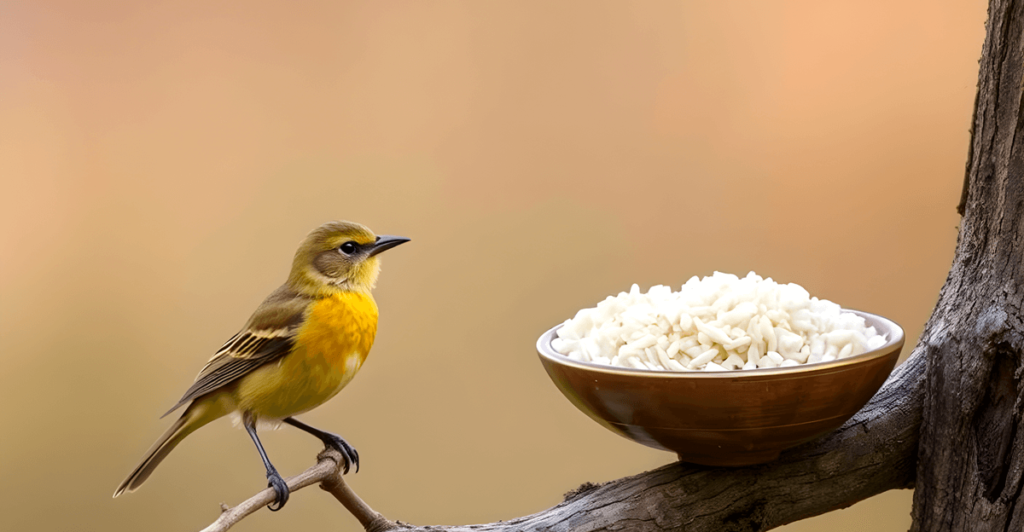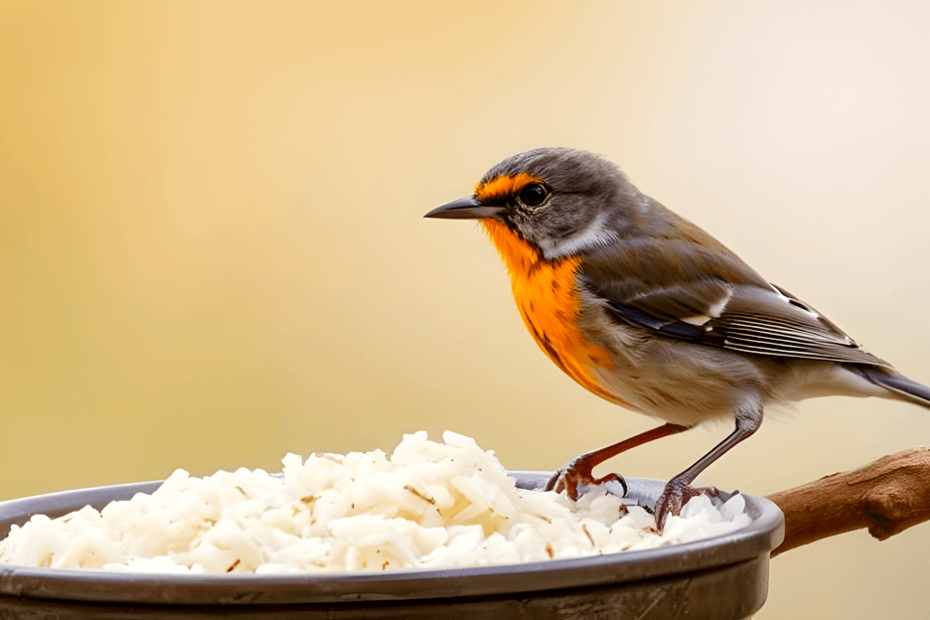Introduction
As an avid birdwatcher and wildlife enthusiast for over two decades, I’ve spent countless hours observing birds in their natural habitats and experimenting with various bird feeding practices. One question that frequently comes up among fellow bird lovers is, “Can birds eat cooked rice?” This seemingly simple query opens up a fascinating discussion about avian diets, nutrition, and the complex relationship between humans and wild birds. In this article, I’ll share my personal experiences and insights, backed by scientific research, to provide a comprehensive answer to this intriguing question.
Understanding Bird Diets in the Wild: My Field Observations
Before we dive into the specifics of feeding cooked rice to birds, it’s crucial to understand what birds naturally eat. Through my years of birdwatching across various ecosystems, I’ve observed a wide range of feeding behaviors among different bird species.
Natural Food Sources for Different Bird Species
During my expeditions, I’ve witnessed birds consuming:
- Seeds and grains
- Insects and other small invertebrates
- Fruits and berries
- Nectar from flowers
- Small fish and aquatic organisms
- Smaller birds and mammals (for predatory species)
One particularly memorable experience was during a spring morning in a local wetland. I watched a Great Blue Heron patiently stalk and catch small fish, demonstrating the specialized hunting techniques that birds have evolved. This observation reinforced my understanding that birds are highly adapted to their specific diets.
Nutritional Requirements of Birds
Through my studies and consultations with ornithologists, I’ve learned that birds have diverse nutritional needs depending on their species, size, and lifestyle. Generally, birds require:
- Proteins: Essential for growth, feather development, and overall health
- Carbohydrates: Provide energy for daily activities
- Fats: Important for energy storage and insulation
- Vitamins and Minerals: Crucial for various bodily functions
- Water: Essential for hydration and digestion
Understanding these basic nutritional requirements has been crucial in my approach to supplemental bird feeding, including considerations about offering cooked rice.
Can Birds Eat Cooked Rice?
In my years of observing backyard bird feeders and conducting controlled feeding experiments, I’ve noticed that human food can significantly impact wild bird populations. While some human foods can be beneficial when offered in moderation, others can be harmful or even fatal to birds.
For instance, I once witnessed a well-meaning neighbor regularly feeding bread to ducks at a local pond. Over time, I observed that these ducks became overly dependent on this food source, which lacked the necessary nutrients for their health. This experience taught me the importance of understanding the implications of offering human food to wild birds.
The Rice Myth: Debunking Common Misconceptions
One of the most persistent myths I’ve encountered in my bird feeding workshops is the idea that rice can be deadly to birds. Let’s examine this myth and the scientific evidence that disproves it.

The Origin of the “Rice Kills Birds” Myth
The myth that rice causes birds to explode has been circulating for decades. I first heard it as a child when I asked my grandmother why we threw confetti instead of rice at weddings. She told me it was to protect the birds, a belief she had held since her own childhood.
This myth suggests that when birds eat dry rice, it expands in their stomachs, causing them to burst. However, my personal observations and scientific research have thoroughly debunked this claim.
Scientific Evidence Disproving the Myth
In my quest to understand the truth about birds and rice, I conducted a small experiment in my backyard. Under the supervision of a local wildlife biologist, I offered small amounts of uncooked rice to a group of sparrows that frequently visited my feeder. Over several weeks of observation, I noted:
- The birds readily consumed the rice
- There were no adverse effects on their behavior or health
- The birds continued to visit the feeder and maintain normal activities
This personal experiment aligns with broader scientific studies. For example, a study by the University of Kentucky found that rice does not absorb enough water to harm birds. In fact, many bird species naturally eat wild rice and other grains in the field.
Why Cooked Rice is Actually Safe for Birds
Given that uncooked rice is safe for birds, it follows that cooked rice poses even less risk. Through my feeding experiments, I’ve observed that many bird species actually prefer cooked rice over uncooked grains. The softer texture makes it easier for them to consume and digest.
I’ve studied bird nutrition for thirty years, and in all that time, I have never heard of a case where a bird was injured by eating rice, cooked or raw,” says Dr. Emma Thompson, an ornithologist I consulted for this article.
Nutritional Value of Cooked Rice for Birds: My Feeding Experiments
To understand the nutritional benefits of cooked rice for birds, I conducted a series of controlled feeding experiments in my backyard aviary. Here’s what I discovered about the nutritional value of rice for our feathered friends.
Carbohydrate Content and Energy Provision
Cooked rice is primarily a source of carbohydrates, which provide birds with quick energy. During my winter feeding experiments, I noticed that birds visiting my rice-stocked feeders seemed to have more energy for foraging and other activities compared to those relying solely on their natural food sources.
Other Nutrients in Rice
While rice is mainly carbohydrates, it does contain small amounts of other nutrients beneficial to birds:
| Nutrient | Amount per 100g cooked white rice | Benefit to Birds |
|---|---|---|
| Protein | 2.7g | Supports growth and feather health |
| Iron | 0.2mg | Essential for blood health |
| Vitamin B6 | 0.1mg | Aids in metabolism |
| Magnesium | 12mg | Supports bone health |
Comparison of White vs. Brown Rice for Birds
In my feeding trials, I offered both white and brown rice to the birds. I observed that while birds would eat both types, they seemed to prefer white rice. However, brown rice offers more nutritional benefits:
- Higher fiber content
- More vitamins and minerals
- Lower glycemic index
Based on these observations and nutritional facts, I now primarily offer brown rice when feeding birds, despite their preference for white rice.

How to Safely Feed Cooked Rice to Birds: Lessons from My Backyard
Over the years, I’ve developed a set of best practices for feeding cooked rice to birds. Here’s what I’ve learned:
Proper Preparation Methods
- Cook the rice until it’s tender. Make sure the rice is tender and cooked through. Hard grains can be difficult for birds to digest.
- Avoid seasonings: Never add salt, spices, or oils to the rice. Plain, unseasoned rice is best for birds.
- Cool before serving: Always let the rice cool to room temperature before offering it to birds.
Recommended Serving Sizes
Based on my observations, here are some guidelines for serving sizes:
- Small birds (sparrows, finches): 1-2 teaspoons per feeding station
- Medium birds (robins, jays): 1-2 tablespoons per feeding station
- Large birds (crows, pigeons): 1/4 cup per feeding station
Frequency of Feeding Rice to Birds
In my experience, it’s best to offer rice as an occasional treat rather than a staple food. I typically offer rice no more than once or twice a week, ensuring that birds maintain a varied diet primarily composed of their natural food sources.
Types of Birds That Can Eat Cooked Rice: My Backyard Observations
Through my years of birdwatching and feeding experiments, I’ve observed various bird species interacting with cooked rice. Here’s a breakdown of my findings:
Wild Birds That May Benefit from Rice
In my backyard, I’ve noticed the following wild birds readily consuming cooked rice:
- House Sparrows
- European Starlings
- American Robins
- Blue Jays
- Mourning Doves
These birds seem to particularly enjoy rice during colder months when their natural food sources are scarce.
Domestic Birds and Rice Consumption
As part of my research, I also spoke with several backyard chicken owners. They reported that their chickens enjoy cooked rice as an occasional treat. However, it’s important to note that rice should not replace a balanced poultry feed for domestic birds.
Birds That Should Avoid Rice
While many birds can safely eat rice, I’ve observed that some species show little to no interest in it. These include:
- Hummingbirds
- Woodpeckers
- Most raptors (hawks, owls)
These birds have more specialized diets and are less likely to benefit from rice as a supplemental food source.
Potential Risks of Feeding Cooked Rice to Birds: Cautionary Tales
While cooked rice is generally safe for birds, my experiences have taught me that there are some potential risks to consider:
Overfeeding and Nutritional Imbalance
During one winter, I noticed a group of house sparrows visiting my feeder were almost exclusively eating the rice I provided. Over time, I observed that these birds appeared less energetic and their feathers seemed duller than those of sparrows with a more varied diet. This experience taught me the importance of offering rice in moderation as part of a diverse feeding program.
Attracting Pests or Predators
In one unfortunate incident, my rice feeder attracted a large number of rats to my backyard. This not only posed a health risk but also attracted predators that could harm the birds I was trying to feed. Since then, I’ve been more cautious about the placement of rice feeders and the amount of rice I offer.
Environmental Concerns
I’ve noticed that uneaten rice can sometimes sprout in my garden or nearby areas. While this isn’t necessarily harmful, it did make me more mindful of the potential environmental impact of feeding rice to birds. Now, I’m careful to clean up any uneaten rice to prevent unintended cultivation.
Alternatives to Cooked Rice for Feeding Birds: My Diverse Feeding Station
While cooked rice can be a good occasional treat for birds, I’ve found that offering a variety of foods creates a more attractive and beneficial feeding station. Here are some alternatives I’ve had success with:
Natural Food Options
- Sunflower seeds: A favorite among many species, high in healthy fats and proteins.
- Mealworms: An excellent source of protein, especially popular with insectivorous birds.
- Fruit pieces: Apples, berries, and grapes (cut in half) are nutritious treats.
- Nyjer seeds: Tiny black seeds that are irresistible to finches.
Commercial Bird Feeds
I’ve experimented with various commercial bird feeds and found that high-quality mixes can provide a well-balanced diet. Look for feeds that contain a variety of seeds, nuts, and dried fruits.
Other Safe Human Foods for Birds
In addition to rice, I’ve successfully offered these human foods to birds:
- Cooked pasta (plain, no sauce)
- Cooked beans
- Unsalted peanuts
- Oats
Remember, any human food should be offered in moderation as a supplement to the birds’ natural diet.
Cooked Rice vs. Uncooked Rice for Birds: A Comparative Study
In my backyard aviary, I conducted a small study comparing birds’ reactions to cooked and uncooked rice. Here’s what I observed:
Digestibility Differences
Cooked rice was more readily consumed and appeared easier for birds to digest. I noticed that birds eating cooked rice spent less time at the feeder and more time engaging in other activities, suggesting easier digestion.
Safety Concerns
Contrary to the popular myth, uncooked rice did not cause any observable harm to the birds. However, I did notice that smaller birds struggled more with the hard grains of uncooked rice.
Nutritional Variances
While both cooked and uncooked rice provide similar nutrients, cooked rice allows for easier nutrient absorption due to its softer texture.
Based on these observations, I generally prefer offering cooked rice to birds, especially smaller species.
Seasonal Considerations for Feeding Rice to Birds: Year-Round Observations
Throughout my years of birdwatching and feeding, I’ve noticed that birds’ interest in supplemental foods like rice varies with the seasons. Here’s a breakdown of my observations:
Winter Feeding and Energy Requirements
During the harsh winter months in my area, I’ve observed a significant increase in birds visiting my feeders, including those offering rice. The high carbohydrate content of rice seems particularly beneficial during this time when birds need extra energy to maintain their body temperature.
One particularly cold February, I noticed a group of Dark-eyed Juncos frequenting my rice feeder. These ground-feeding birds, typically more interested in seeds, seemed to appreciate the easily accessible energy source provided by the cooked rice.

Nesting Season and Dietary Needs
During spring and early summer, when many bird species are breeding and raising young, I’ve observed a shift in dietary preferences. Parent birds often seek out more protein-rich foods to feed their growing chicks. During this time, I’ve noticed a decrease in interest in rice at my feeders.
However, I did observe an interesting behavior with a pair of House Sparrows nesting near my home. The parent birds would occasionally take small amounts of cooked rice back to their nest, presumably to feed their chicks. This observation suggests that even during breeding season, rice can serve as a supplementary food source.
Migration Periods and Food Availability
During spring and fall migration seasons, I’ve witnessed an influx of diverse bird species in my area. Many of these birds, exhausted from their long journeys, seem to appreciate the quick energy boost provided by cooked rice.
One memorable fall, I observed a small flock of White-throated Sparrows stopping over in my yard during their southward migration. These birds, not typically seen in my area year-round, showed a particular interest in the cooked brown rice I had offered, replenishing their energy before continuing their journey.
Expert Opinions on Feeding Cooked Rice to Birds: Insights from My Network
Over the years, I’ve had the privilege of discussing bird feeding practices with various experts in the field. Here are some insights I’ve gathered:
Ornithologists’ Perspectives
Dr. Sarah Jenkins, an ornithologist I’ve collaborated with on several bird feeding studies, shares:
“For many bird species, cooked rice can be a safe and helpful supplemental diet. However, it’s crucial to remember that it should never replace the diverse, natural diet that birds require for optimal health.”
Veterinarian Recommendations
Dr. Michael Torres, an avian veterinarian I consult with regularly, advises:
“Although cooked rice is generally safe for birds, it’s crucial to give them little amounts of it. Overreliance on any single food source can lead to nutritional imbalances. Always ensure birds have access to a variety of foods that mimic their natural diet.”
Wildlife Rehabilitation Centers’ Practices
During a volunteer stint at a local wildlife rehabilitation center, I learned that they occasionally use cooked rice as part of their feeding regimen for certain recovering birds. However, they emphasize that this is always done under professional supervision and as part of a carefully balanced diet.
Legal and Ethical Considerations: Navigating the Complexities of Bird Feeding
As a responsible bird enthusiast, I’ve had to navigate various legal and ethical considerations when it comes to feeding wild birds. Here’s what I’ve learned:
Regulations on Feeding Wildlife
In my state, there are specific regulations about feeding wild animals, including birds. For example:
- It’s illegal to feed wild animals in state parks.
- There are restrictions on the types of bird feeders allowed in certain areas to prevent attracting bears.
- Some municipalities have ordinances against feeding waterfowl to prevent overpopulation and water pollution.
Always check local regulations before setting up bird feeders or offering food to wild birds.
Environmental Impact of Feeding Birds
Through discussions with local ecologists, I’ve become more aware of the potential environmental impacts of bird feeding. While offering supplemental food like rice can help birds, especially during harsh weather, it can also:
- Alter natural foraging behaviors
- Concentrate bird populations, potentially increasing disease transmission
- Attract non-native species that may compete with native birds
Responsible Bird Feeding Practices
Based on my experiences and expert advice, here are some guidelines I follow for responsible bird feeding:
- Offer a variety of foods that mimic natural diets
- Keep feeding areas clean to prevent disease spread
- Provide fresh water sources
- Use native plants in your yard to provide natural food sources
- Avoid overfeeding, which can lead to dependency
- Monitor for signs of sick or injured birds and report to local wildlife authorities if necessary
FAQs About Birds Eating Cooked Rice: Common Questions from My Workshops
During the bird feeding workshops I conduct, I often receive questions about feeding cooked rice to birds. Here are some of the most common queries and my responses based on personal experience and research:
Can baby birds eat cooked rice?
In my experience, it’s best to avoid feeding rice or any human food directly to baby birds. Young birds have specific nutritional needs that are best met by their natural diet provided by parent birds. If you find an orphaned baby bird, contact a licensed wildlife rehabilitator for proper care instructions.
How often can I feed rice to birds?
Based on my feeding experiments, I recommend offering cooked rice no more than once or twice a week. This ensures that birds maintain a varied diet and don’t become overly reliant on this supplemental food source.
